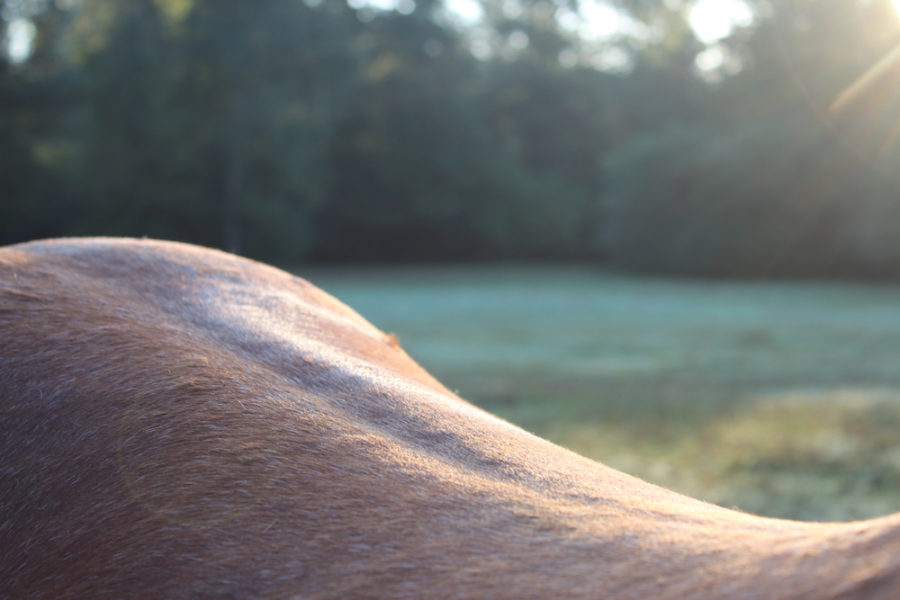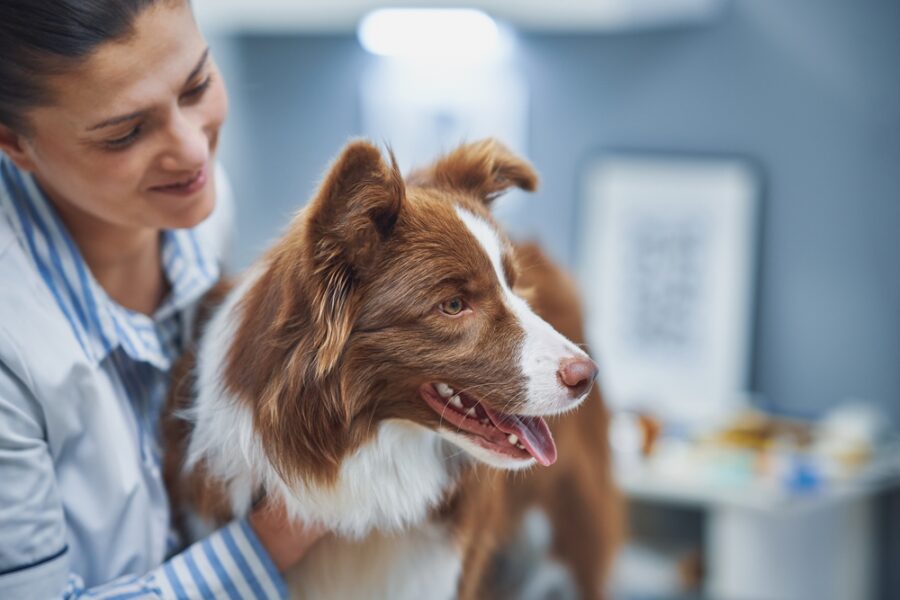Learn how gently palpating certain areas along your horse’s back can help promote mobility and reduce restriction in her lumbar spine.
It’s very common for horses to experience some hind limb soreness that can be traced to the lumbar spine. The hindquarters translate movement from the hind legs up through the pelvis to the spine. Ideally, that movement should travel freely, but if there is any contraction or restriction along that spinal column, it can cause a shortened or irregular stride and other noticeable challenges. Performing some basic lumbar work can help prevent these challenges, and significantly improve any existing issues.
Getting started
The work presented here is guided by principles that make healing very simple. Using a technique called Ortho-Bionomy® – a non-force, osteopathic-derived modality addressing the central nervous system – you can employ the body’s self-corrective response.
Perform a visual inspection
With a visual inspection, see if the lumbars form a natural curve, are flat, or raised. Do they make a smooth transition at the thoracolumbar joint and the lumbosacral joint?
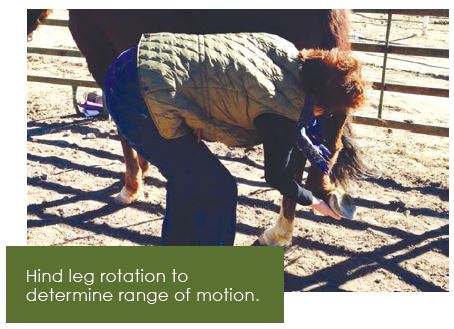 Movement assessment
Movement assessment
Walk the horse forward a few steps, then ask her to disengage the hindquarters, circling towards you to the left, then again to the right. How fluidly can the horse cross her inside leg under herself in that disengagement? Is it sticky? Is she twirling on the supporting leg?
Take note of what you see because you’re going to check it again afterwards. But try not to get too attached to what you see; rather, simply put your observations in your mental toolbox as you are putting together a holistic picture of your observations, palpations and the horse’s responses to techniques.
More on Ortho-Bionomy®
Developed in 1976 by Canadian osteopath and martial arts instructor, Arthur Lincoln Pauls, Ortho-Bionomy is a gentle form of bodywork that uses non-force techniques to encourage the body into self-correction. The modality is built on the principles that an individual’s body can change through natural and invited movement, as well as comfortable positioning. An Ortho-Bionomy practitioner strives to meet the individual as he is, exaggerating preferred postures and always moving in the direction of comfort.
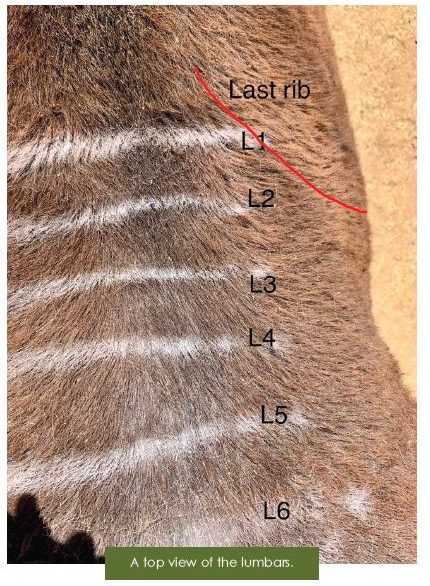 Palpation
Palpation
To begin, use your fingertips or the pads of your fingers to gently palpate the area along the lumbar spine (see diagram at right). In Ortho-Bionomy, the lateral edge of the transverse processes of the lumbar vertebra is used as an indicator point for the lumbar techniques. Horses generally have six lumbar vertebrae. The sixth lumbar connects to the sacrum, which doesn’t have twisting rotation like the lumbars. At the sixth lumbar, flexion and extension increase into the lumbosacral junction.
It’s important to note that while there is less overall movement in the lumbar spine, its movement and relationship to the rest of the topline is pivotal. The relationship between parts of the spine that move a great deal, and those that don’t move much, provides an opportunity for discord in the joints.
Palpate the area around the transverse processes to get a sense of the connection between the lumbar and hind leg. Identify the tender, tight or atrophied areas.
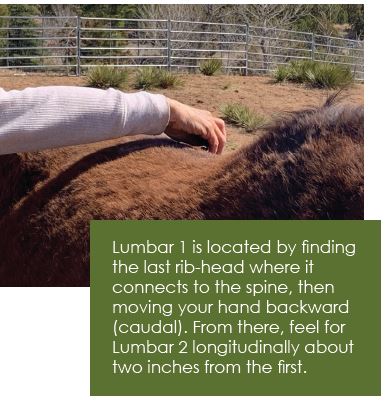 Technique
Technique
- On the opposite side from the affected vertebra, place your hand on or just under the point of the hip and apply light pressure toward the affected lumbar. Place your fingertips lightly on the affected lumbar to feel for a response. This is a very dense area so you may not feel a lot of response.
- Hold the lumbar position until the horse readjusts or releases. A release may include yawning, sneezing, licking and chewing.
- Recheck the point.
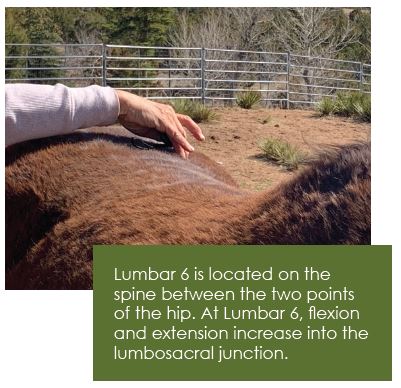 Next, take each hind limb and rotate it in a circle both clockwise and counter-clockwise, without force. You may feel a glitchy area, where the horse doesn’t want to rotate through. Don’t force it. Instead, back your movement out of that glitchy area and compress up towards the lumbars. Let the horse bring her leg down naturally and gently. If there is more than one glitchy area, do the same with the others.
Next, take each hind limb and rotate it in a circle both clockwise and counter-clockwise, without force. You may feel a glitchy area, where the horse doesn’t want to rotate through. Don’t force it. Instead, back your movement out of that glitchy area and compress up towards the lumbars. Let the horse bring her leg down naturally and gently. If there is more than one glitchy area, do the same with the others.
If the horse is resistant to lifting her legs in any of these techniques, repeat Steps 1, 2 and 3.
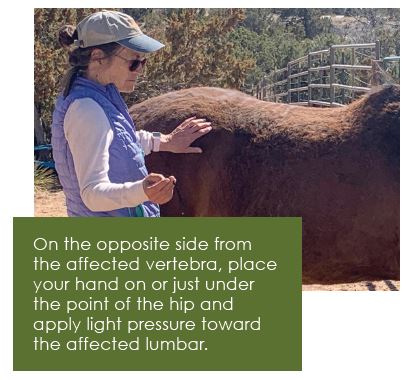 Recheck by disengaging the hindquarters and/or by lifting the hinds and rotating them again to see if the glitchy areas are still there. If there is still some restriction, repeat the techniques once more.
Recheck by disengaging the hindquarters and/or by lifting the hinds and rotating them again to see if the glitchy areas are still there. If there is still some restriction, repeat the techniques once more.
Booking an appointment with your veterinarian should always be the first course of action if your horse displays any discomfort. However, regularly performing this gentle technique on your horse will help work through any minor restrictions in her lumbar spine so she can feel – and perform at – her best!
How can I tell if my horse needs lumbar spine work?
Movement of the lumbar spine involves flexion and extension with some twisting rotation and lateral flexion. An ill-fitting saddle or some spinal misalignment can cause pain in that immediate region. The horse may indicate she has pain in the lumbars by shrinking from touch in the gluteal muscles or around the edges of the sacrum. Even if your horse is sore on the forehand or somewhere else in the body, lumbar work can relieve tension in the entire spine and even shoulders.

